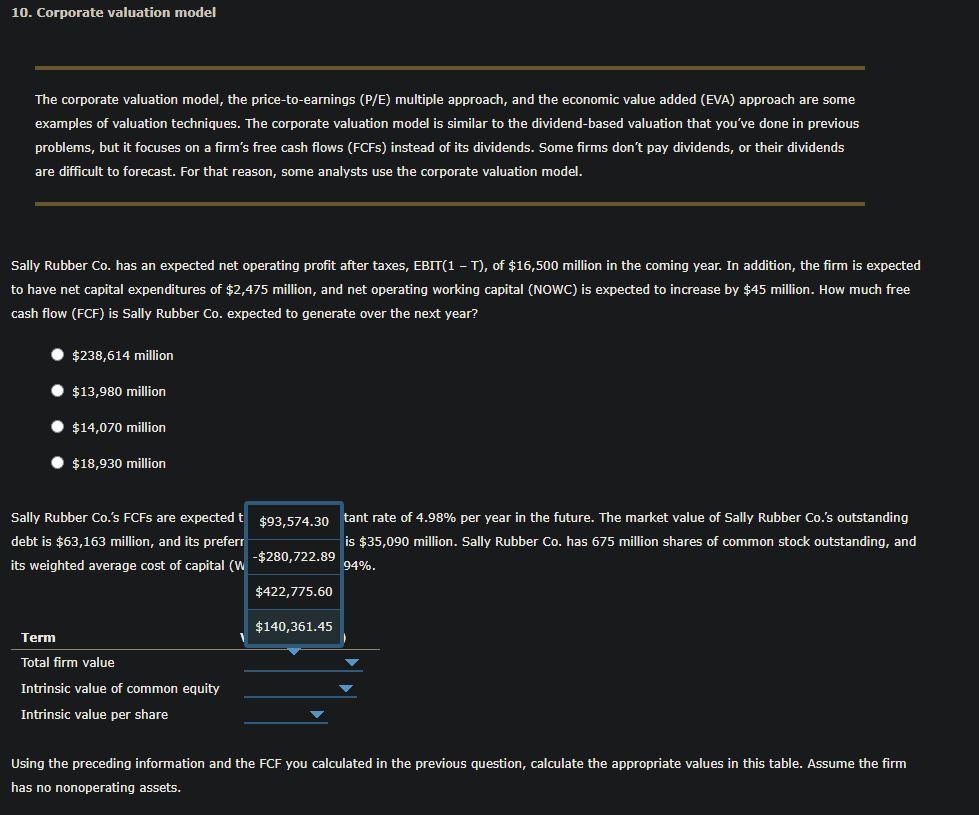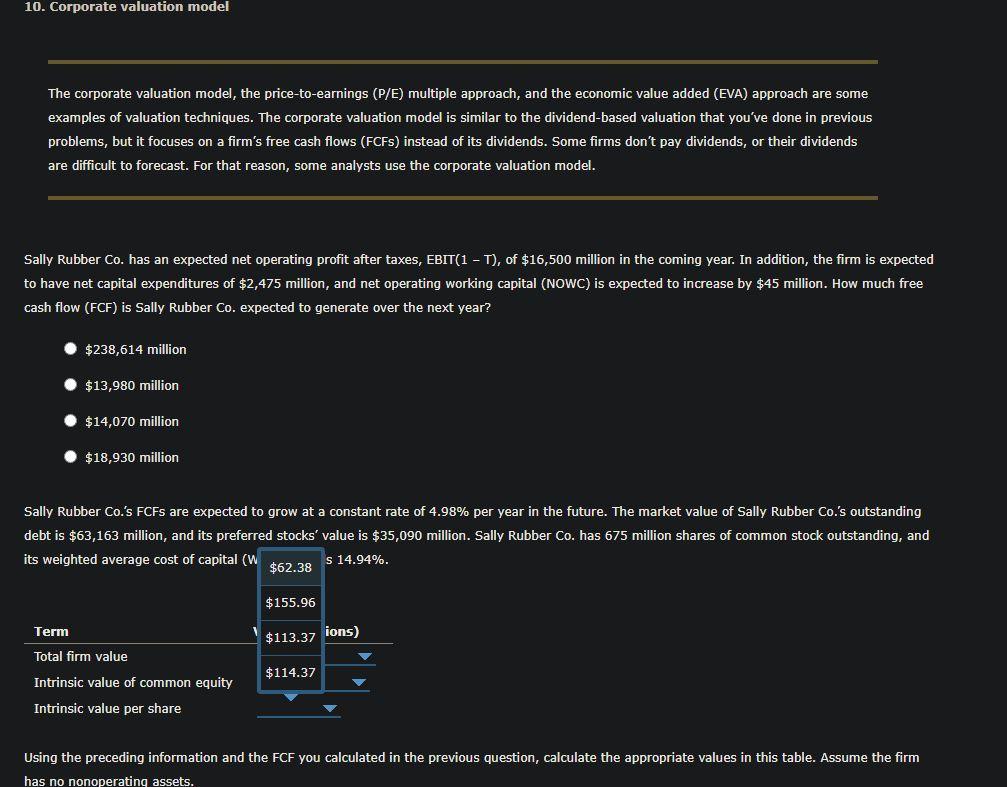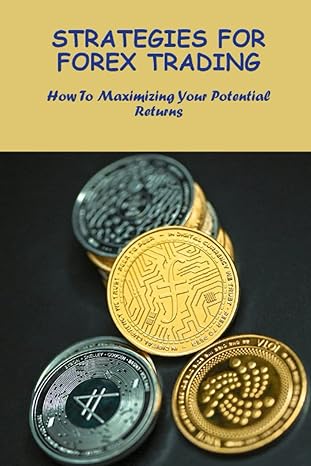Hi I am finding this problem challenging, can I ask for how to do this problem? Thanks!




10. Corporate valuation model The corporate valuation model, the price-to-earnings (P/E) multiple approach, and the economic value added (EVA) approach are some examples of valuation techniques. The corporate valuation model is similar to the dividend-based valuation that you've done in previous problems, but it focuses on a firm's free cash flows (FCFS) instead of its dividends. Some firms don't pay dividends, or their dividends are difficult to forecast. For that reason, some analysts use the corporate valuation model. Sally Rubber Co. has an expected net operating profit after taxes, EBIT(1 - T), of $16,500 million in the coming year. In addition, the firm is expected to have net capital expenditures of $2,475 million, and net operating working capital (NOWC) is expected to increase by $45 million. How much free cash flow (FCF) is Sally Rubber Co. expected to generate over the next year? $238,614 million $13,980 million $14,070 million $18,930 million Sally Rubber Co.'s FCFs are expected to grow at a constant rate of 4.98% per year in the future. The market value of Sally Rubber Co.'s outstanding debt is $63,163 million, and its preferred stocks' value is $35,090 million. Sally Rubber Co. has 675 million shares of common stock outstanding, and its weighted average cost of capital (WACC) equals 14.94%. Term Value (Millions) Total firm value Intrinsic value of common equity Intrinsic value per share Using the preceding information and the FCF you calculated in the previous question, calculate the appropriate values in this table. Assume the firm has no nonoperating assets. 10. Corporate valuation model The corporate valuation model, the price-to-earnings (P/E) multiple approach, and the economic value added (EVA) approach are some examples of valuation techniques. The corporate valuation model is similar to the dividend-based valuation that you've done in previous problems, but it focuses on a firm's free cash flows (FCFS) instead of dividends. Some firms don't pay dividends, or their dividends are difficult to forecast. For that reason, some analysts use the corporate valuation model. Sally Rubber Co. has an expected net operating profit after taxes, EBIT(1 - 1), of $16,500 million in the coming year. In addition, the firm is expected to have net capital expenditures of $2,475 million, and net operating working capital (NOWC) is expected to increase by $45 million. How much free cash flow (FCF) is Sally Rubber Co. expected to generate over the next year? $238,614 million $13,980 million $14,070 million $18,930 million Sally Rubber Co.'s FCFs are expected t debt is $63,163 million, and its preferr its weighted average cost of capital (W $93,574.30 tant rate of 4.98% per year in the future. The market value of Sally Rubber Co.'s outstanding is $35,090 million. Sally Rubber Co. has 675 million shares of common stock outstanding, and -$280,722.89 94%. $422,775.60 $140,361.45 Term Total firm value Intrinsic value of common equity Intrinsic value per share Using the preceding information and the FCF you calculated in the previous question, calculate the appropriate values in this table. Assume the firm has no nonoperating assets. 10. Corporate valuation model The corporate valuation model, the price-to-earnings (P/E) multiple approach, and the economic value added (EVA) approach are some examples of valuation techniques. The corporate valuation model is similar to the dividend-based valuation that you've done in previous problems, but it focuses on a firm's free cash flows (FCFS) instead of its dividends. Some firms don't pay dividends, or their dividends are difficult to forecast. For that reason, some analysts use the corporate valuation model. Sally Rubber Co. has an expected net operating profit after taxes, EBIT(1 - T), of $16,500 million in the coming year. In addition, the firm is expected to have net capital expenditures of $2,475 million, and net operating working capital (NOWC) is expected to increase by $45 million. How much free cash flow (FCF) is Sally Rubber Co. expected to generate over the next year? $238,614 million $13,980 million $14,070 million $18,930 million Sally Rubber Co.'s FCFs are expected to grow at a constant rate of 4.98% per year in the future. The market value of Sally Rubber Co.'s outstanding debt is $63,163 million, and its preferred stocks' value is $35,090 million. Sally Rubber Co. has 675 million shares of common stock outstanding, and its weighted average cost of capital (W s 14.94%. $62.38 $155.96 Term $113.37 ions) Total firm value Intrinsic value of common equity $114.37 Intrinsic value per share Using the preceding information and the FCF you calculated in the previous question, calculate the appropriate values in this table. Assume the firm has no nonoperating assets. Attempts: 0 0.7 Keep the Highest: 0.712 8. Nonconstant growth stock As companies evolve, certain factors can drive sudden growth. This may lead to a period of nonconstant, or variable, growth. This would cause the expected growth rate to increase or decrease, thereby affecting the valuation model. For companies in such situations, you would refer to the variable, or nonconstant, growth model for the valuation of the company's stock. Consider the case of Portman Industries: Portman Industries just paid a dividend of $1.44 per share. The company expects the coming year to be very profitable, and its dividend is expected to grow by 12.00% over the next year. After the next year, though, Portman's dividend is expected to grow at a constant rate of 2.40% per year. Assuming that the market is in equilibrium, use the information just given to complete the table. Term Value Dividends one year from now (D:) Horizon value (1) Intrinsic value of Portman's stock $42.97 The risk-free rate (IRF) is 3.00%, the m $41.93 premium (RPM) is 3.60%, and Portman's beta is 0.90. $68.75 What is the expected dividend yield for stock today? $26.44 3.98% 3.07% 3.75% 3.84%










